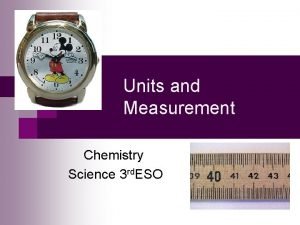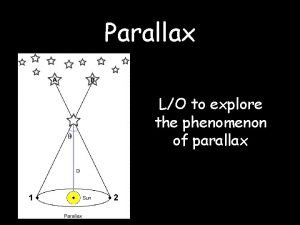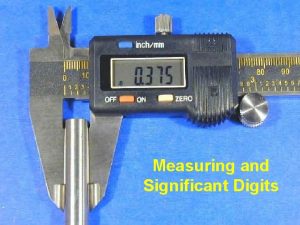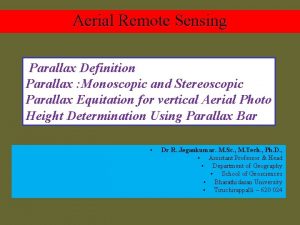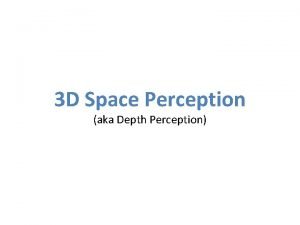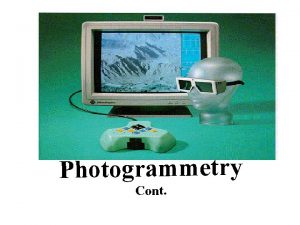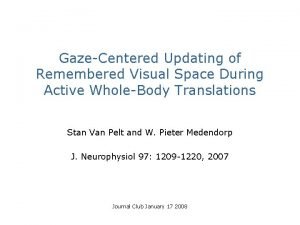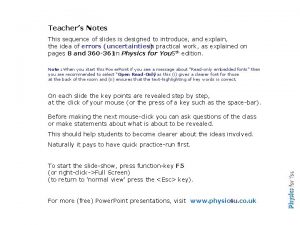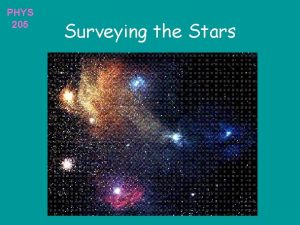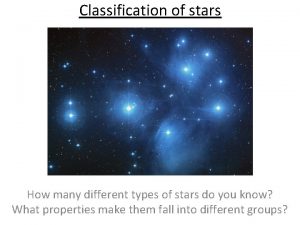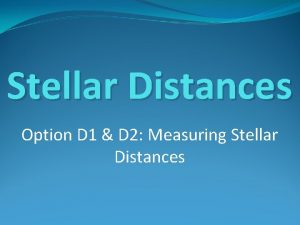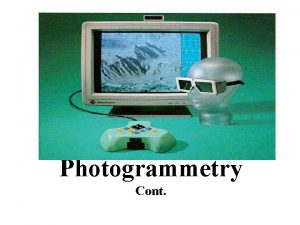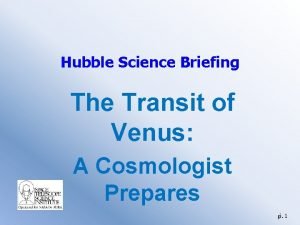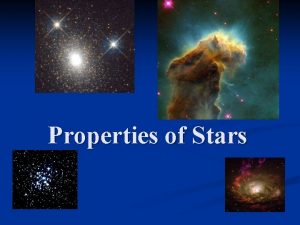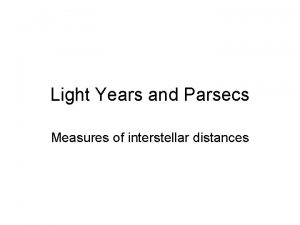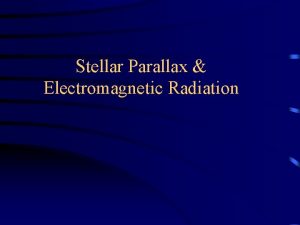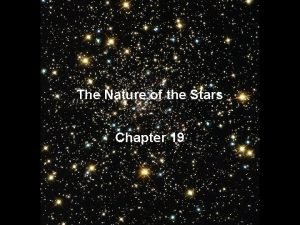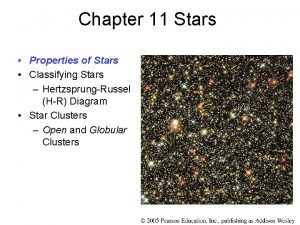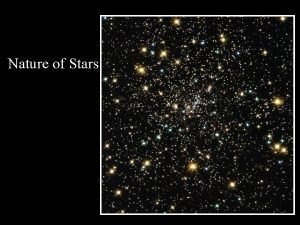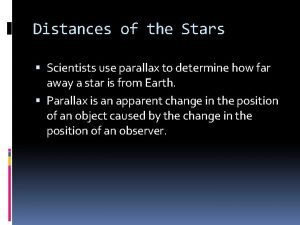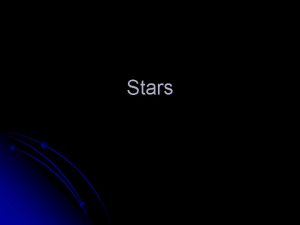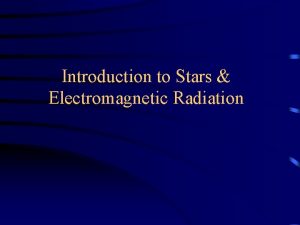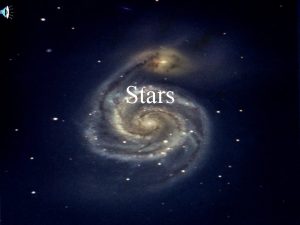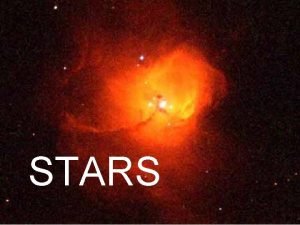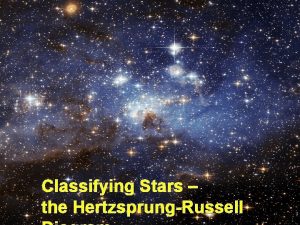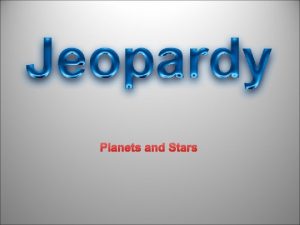26 2 Stars Chapter 26 2 Parallax Video





























- Slides: 29

26. 2 Stars Chapter 26. 2 Parallax Video Lecture Birth of Stars Video Lecture

26. 2 Stars Proxima Centauri, the red star at the center, is the closest star to the sun.

26. 2 Stars A star is a large, glowing ball of gas in space, which generates energy through nuclear fusion in its core. The closest star to Earth is the sun, which is considered to be a fairly average star.

26. 2 Stars Distance to the Stars The Light-Year A light-year is the distance that light travels in a vacuum in a year, which is about 9. 5 trillion kilometers. • Proxima Centauri, the closest star to the sun, is about 4. 3 light-years away.

26. 2 Stars Parallax Stars are so far away that astronomers cannot measure their distances directly. Astronomers are able to observe stars from two different positions–opposite sides of Earth’s orbit. Nearby stars appear to move against the moredistant background stars.

26. 2 Stars You can observe parallax by holding your thumb in front of you and looking at it first with one eye and then with the other.

26. 2 Stars With the invention of the telescope, astronomers could measure the positions of stars with much greater accuracy. • The closer a star is to Earth, the greater is its parallax.

26. 2 Stars Properties of Stars Color and Temperature A star’s color indicates the temperature of its surface. • The hottest stars, appear blue. • The cooler stars appear red • Stars with surface temperatures between 5000 and 6000 K appear yellow, like the sun.

26. 2 Stars Betelgeuse, Procyon, and Sirius are three of the brightest stars in the sky. Betelgeuse is a much cooler star than the others.

26. 2 Stars Brightness The sun appears very bright to us because it is much closer than other stars. The brightness of a star as it appears from Earth is called its apparent brightness. The apparent brightness of a star decreases as its distance from you increases.

26. 2 Stars These streetlights all have about the same absolute brightness, but the closer lights appear brighter.

26. 2 Stars Absolute brightness is how bright a star really is. You can calculate a star’s absolute brightness if you know its distance from Earth and its apparent brightness.

26. 2 Stars Size and Mass Once astronomers know a star’s temperature and absolute brightness, they can estimate its diameter and then calculate its volume. For most stars, there is a relationship between mass and absolute brightness.

26. 2 Stars Composition Astronomers can use spectrographs to identify the various elements in a star’s atmosphere. Each element in a star absorbs light of different wavelengths. A star’s bright spectrum has a set of dark lines called absorption lines that show where light has been absorbed.

26. 2 Stars This is the spectrum of a star. The dark absorption lines indicate the presence of various elements in the star.

26. 2 Stars These observations have shown that the composition of most stars is fairly similar to the sun, with hydrogen and helium together making up 96 to 99. 9 percent of the star’s mass.

26. 2 Stars The Hertzsprung-Russell Diagram Stars can be classified by locating them on a graph called a Hertzsprung-Russell diagram, or H-R diagram. An H-R diagram is a graph of the surface temperature, or color, and absolute brightness of a sample of stars.

26. 2 Stars The horizontal axis shows surface temperatures of stars. A star’s color is directly related to its surface temperature. The hottest blue stars are on the left. The coolest red stars are on the right.

26. 2 Stars The vertical axis of the H-R diagram shows absolute brightness, with the brightest stars at the top and the faintest at the bottom.

26. 2 Stars A star’s placement on an H-R diagram indicates its absolute brightness and surface temperature (or color).

26. 2 Stars Main-Sequence Stars occur only in certain places on the H-R diagram. 90% of all the stars are found along a diagonal band running from the bright hot stars on the upper left to the dim cool stars on the lower right. This diagonal band on the H-R diagram is called the main sequence. The sun lies near the middle of this band.

26. 2 Stars The very bright stars at the upper right of the H-R diagram are called supergiants. Just below the supergiants on the H-R diagram are the giants—large, bright stars that are smaller and fainter than supergiants.

26. 2 Stars Below the main sequence in the lower part of the HR diagram are white dwarfs. • A white dwarf is the small, dense remains of a low- or medium-mass star.

26. 2 Stars Assessment Questions 1. What is the unit of distance that scientists use to measure distances between the solar system and other stars? a. b. c. d. astronomical unit parallax stellar unit light-year

26. 2 Stars Assessment Questions 1. What is the unit of distance that scientists use to measure distances between the solar system and other stars? a. b. c. d. astronomical unit parallax stellar unit light-year ANS: D

26. 2 Stars Assessment Questions 2. The stars with the highest surface temperatures can be identified because they are a. b. c. d. the brightest stars in the sky. moving away from Earth. the most massive. blue.

26. 2 Stars Assessment Questions 2. The stars with the highest surface temperatures can be identified because they are a. b. c. d. the brightest stars in the sky. moving away from Earth. the most massive. blue. ANS: D

26. 2 Stars Assessment Questions 3. What two characteristics of main sequence stars show an approximately linear relationship on the Hertzsprung-Russell diagram? a. mass and volume b. absolute brightness and the percentage of helium in the star c. diameter and surface temperature d. surface temperature and absolute brightness

26. 2 Stars Assessment Questions 3. What two characteristics of main sequence stars show an approximately linear relationship on the Hertzsprung-Russell diagram? a. mass and volume b. absolute brightness and the percentage of helium in the star c. diameter and surface temperature d. surface temperature and absolute brightness ANS: D
 Mary daniels is a student in england
Mary daniels is a student in england Yandex ru video search text
Yandex ru video search text Yahoo search video
Yahoo search video Searchyahoo
Searchyahoo The frame size of a video refers to the video’s
The frame size of a video refers to the video’s Metric system of measurement
Metric system of measurement Phenomenon of parallax
Phenomenon of parallax Parallax may be eliminated by
Parallax may be eliminated by Error
Error Absolute or relative error
Absolute or relative error Jquery keyframes
Jquery keyframes Chapter 23 bowel elimination
Chapter 23 bowel elimination Parallax bar
Parallax bar Motion parallax
Motion parallax Parallactic angle in photogrammetry
Parallactic angle in photogrammetry What is motion parallax
What is motion parallax Parallax error random or systematic
Parallax error random or systematic Parallax in surveying
Parallax in surveying Apparent shift in measurement
Apparent shift in measurement What is stellar parallax?
What is stellar parallax? Relaxed cone step mapping
Relaxed cone step mapping 385 f to c
385 f to c Parallax method
Parallax method Stereoscopic parallax
Stereoscopic parallax Solar parallax
Solar parallax Physiology of bowel elimination
Physiology of bowel elimination Classify stars
Classify stars Parsecs to light-years
Parsecs to light-years Parallax error
Parallax error Constancy psychology
Constancy psychology





